Spanish Practices in Regent St
Regent St, London, Sun 31 May, 2009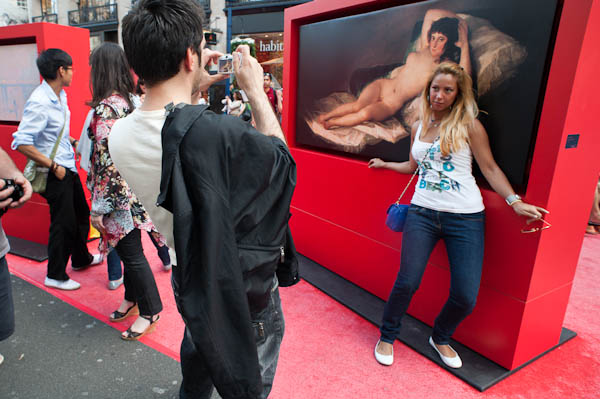
The Prado was displaying prints of its best-known works
More pictures
The 'Taste of Spain' festival in Regent Street seemed rather bland
as well as rather too crowded in places. The display of pictures from the
Prado in Madrid largely attracted attention because of the female nudity in
some of the works (and it's a shame that Ruskin had apparently not studied
this work in detail before his wedding night, which might then have been less
of a shock to his system.) Quite a few people posed in front of it to have
their picture taken - but by their friends rather than by me.
Reproductions of works of art such as this raise an important point of copyright.
Firstly, Goya's painting although owned by the Prado is in the public domain
in copyright terms, as he died over 70 years ago. As the reproduction of it
was intended to be a faithful 2D representation - which clearly was intended
- it lacks the artistic intent necessary for copyright to exist and so is
also in the public domain. However copyright lawyers in the employ of many
museums and photographic agencies who make money selling or licencing art
reproductions take a rather diffferent view of intellectual property law.
more pictures
Hizb ut-Tahrir protest US War in Pakistan
US Embassy - Pakistan High Commission, London. Sun 31 May, 2009
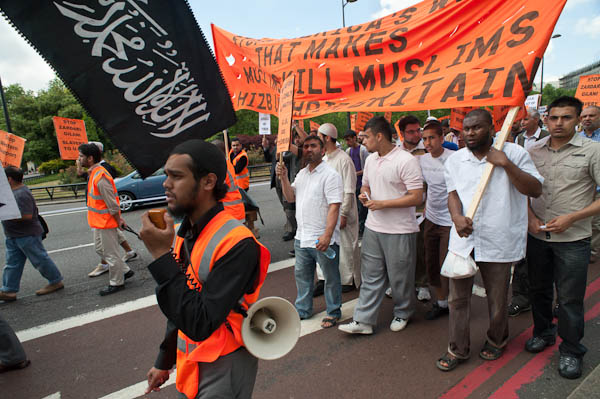
Speaker reaching up to the US Eagle at the front of the
Embassy in Grosvenor Square
more pictures
Over a thousand Muslims marched from a rally outside the US Embassy in London
to the Pakistan High Commission this afternoon (Sunday 31 May) in protest
against the attacks by the Pakistani army in Swat. The protest, organised
by Hizb ut-Tahrir Britain, called these attacks an "American War",
blaming them on American pressure on the Pakistan government and called for
an immediate end to attacks by Muslims on Muslims.
As they marched, the protesters chanted a long list of slogans in English
and Arabic, including "Zandar's shameful treachery obeying America's
Policy", "One Million Muslim Refugees Left their Homes Forced to
Flee" and "Muslim Killing Muslim is Haram, Save Yourself from this
Harm."
Taji Mustafa, media representative of Hizb ut-Tahrir Britain said, "At
the behest of America, the Zardari regime is creating a disastrous civil war
in Pakistan leading to the loss of her sons in the army, the death of men,
women and children in Swat and the displacement of over 1.5 million Muslims
in order to further America’s agenda of weakening Pakistan. The root
cause of this bloodshed is Obama’s expansion of America’s war
on terror and Zardari’s collusion with the US against the people of
Pakistan."
Hizb ut-Tahrir's major objective is the replacement of the present corrupt
rulers of Muslim countries - including Pakistan - by an Islamic Khilafah (Caliphate)
that will be independent of Western influence.
The march was in support of Hizb ut-Tahrir rallies taking place on the same
day in several cities in Pakistan.
The London march was split into three groups, with men in the front and rear
and women in the centre group. During the two rallies, the women stood well
to one side and all of those speaking were men.
We've seen Muslim women increasingly taking an active role in British society,
working as doctors, teachers, lawyers and playing an active role in politics
- for example in the Stop the War movement. Surely any modern caliphate -
such as Hizb ut-Tahrir want to establish will need to have a proper respect
for human rights, including the rights of women, although an Islamic interpretation
of this may well differ in some respects from a Western one. It's very hard
not to agree with Hizb ut-Tahrir when it talks about the corrupt regimes currently
leading Muslim countries, but it would also be welcome to see them standing
against repression - and in particular the repression of women - that is currently
practicised in places including Swat and states such as Iran. Listening to
the voices of women at their rallies would perhaps be a good starting point.
more pictures
Wedding 'Die-In' Against Afghanistan War
Northwood, Middlesex. Wednesday 27 May, 2009
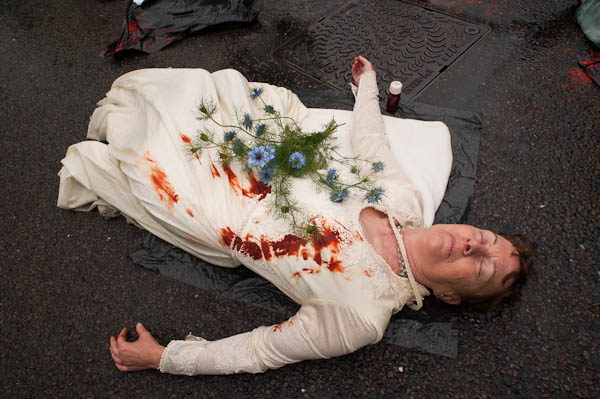
A bloodstained 'bride' lies on a cold wet road outside London's Afghanistan
War Base
more pictures
Two years ago today, on May 27, 2007, US forces in Afghanistan bombed a wedding
party at Haji Nabu, killing 47 civilians; just one of numerous wedding parties
massacred by NATO or US forces. Thousands of Afghan civilians have been killed
by US/NATO forces in the war, and earlier this month, on May 4, around 120
civilians, mainly women and children were killed in an attack in Farah province.
To mark these killings and call for an end to the killing in Afghanistan,
protesters from Voices in the Wilderness UK, Justice Not Vengeance
and London and Oxford Catholic Workers organised a 'die-in',
an act of non-violent civil disobedience close to the main gate of 'HMS
Warrior', the land-based Permanent Joint Headquarters in Northwood in
London from which Britain's forces in Afghanistan are commanded.
It was a cold, wet morning when around 30 demonstrators, dressed for a wedding
and including two brides and grooms, met at Northwood station for a march
to the base. There were considerably more police than demonstrators, and after
some negotiation the police agreed that the march would be allowed to proceed
to a wide verge 200 metres from the main gate of the base.
On the way there were further discussions about the exact route, but after
threatening to block the road with a 'die-in' the march was allowed to reach
the road opposite the grass verge on which the police had wanted them to protest,
and their path to the main gate, a short distance further on was blocked by
a line of police.
The march organisers had previously decided they would stage the 'die-in'
at the point they were stopped by the police from going further, and around
half the demonstrators lay down on the road. Fortunately the organisers had
come with a supply of black bin bags to put on the wet surface, but it was
still cold and uncomfortable, and the rain, although light, was steady.
The rest of the protesters began a reading of the names of civilians killed
in Afghanistan from the side of the road. Among those taking part in the protest
were Maya Evans and Milan Rai who were arrested in 2005 for reading out the
names of Iraqis and British soldiers killed in the Iraq War, opposite the
Cenotaph in Whitehall. Rai became the first person to be convicted under SOCPA
for organising an unauthorised demonstration in the vicinity of Parliament.
Also present was Hillingdon MP John McDonnell
The Hertfordshire police had previously given a warning under Section 14
of the Public Order Act. They gave a further warning once people had 'died'
on the roadway, but stood watching. After around 15 minutes, a second officer
gave a warning that unless people cleared the road they would be moved, and
said that they had 5 minutes to decide. Twenty minutes later a final warning
was issued, and then groups of police moved to each protester on the road
in turn. Each was told they were committing an offence and that unless they
moved they would be carried to the side of the road, and that if they attempted
to move back on to the road they would be arrested.
Several demonstrators got up and walked to the side, but most waited for
the police to move them, which appeared to be done firmly but with minimum
force. At one point the officer in charge directed his men to deal with one
man before the other remaining protesters because he was obviously shivering
and suffering from the cold. And as a photographer the Hertfordshire police
made a pleasant change from the Met. For once I was only told to get out of
the way when I was really in the way. There were some FIT officers from the
Met present - let's hope they take some intelligence back to their force about
how to police protest.
I saw one man who came back on the roadway being arrested and led away, but
I was told that there were five other arrests of people who had defied the
police injunction not to move back onto the road.
The organisers had intended that the 'die-in' should last an hour; it began
at 12.22 and the removal by police started at 12.58 and was complete by 13.08,
just three-quarters of an hour after the start. A few minutes later the police
agreed to let the protesters march back down the road to the station.
more pictures
A Day Off - Canal Walk
Grand Union Canal: Wendover and Aylesbury. Mon 25 May, 2009
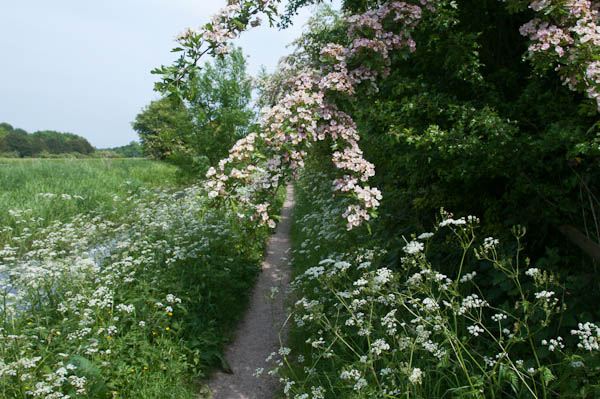 A
day out from London . Path by a disused section of the Wendover arm of the
Grand Union Canal - at left
A
day out from London . Path by a disused section of the Wendover arm of the
Grand Union Canal - at left
more pictures
I spent the bank holiday on a walk with family in the country, not far to
the north of London, though it seemed like a different country. Had I known
it was going to be around 18 miles I might have turned down the invitation,
but at least being a canal walk it was mainly flat.
Starting from Tring station we walked north on the main line of the Grand
Union then turned down the Wendover Arm. The canal was closed in 1897, 100
years after its opening, and the first 1.3 miles reopened in 2005. The next
section of around 1.7 miles is expected to be completed in 2010, but you can
walk the full 6.7 miles to Wendover as we did. After taking a walk around
Wendover we took the train to Aylesbury, where we spent another hour or so
wandering around the town centre before walking the six miles of the Aylesbury
Arm back to the Grand Union, and after a short stop at a canal-side pub in
Bulborne, the two and a half miles back to Tring station.
The canals are of course not without interest. In the age they were built
a considerable investment in manpower, money and engineering, and making a
great impact on the economy, lives and landscape. Our guidebook tells us that
when the canal to Aylesbury opened in 1814, the cost of coal in that town
was immediately halved.
One of the leading British photographers of the mid-20th century, Eric
de Maré (1910-2002), whose Penguin guide to photography published
in 1957 got many of us started, played an important role in reviving interest
in the canals as their commercial role was fading. In 1948 he made a 600 mile
boat journey, photographing and documenting them, publishing his The Canals
of England in 1950. It was a significant contribution to the start of
canal cruising as a leisure pursuit, now the main role of our canal system.
more pictures
National Demonstration against Police Violence
Trafalgar Square to New Scotland Yard. Saturday 23 May, 2009
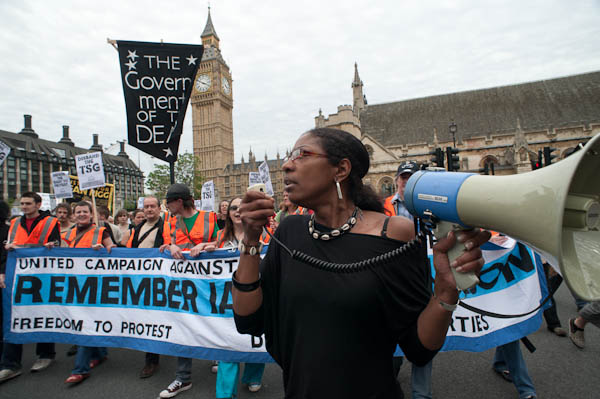 The
front of the march in Parliament Square
The
front of the march in Parliament Square
more pictures
Around a thousand people took part in a National Demonstration against Police
Violence in London yesterday (Saturday 23 May,) organised by the United Campaign
Against Police Violence, set up following the G20 demonstration in London
in which Ian Tomlinson, a man not taking part in the demonstration, was assaulted
by police and died.
The coalition includes trade unionists and activists involved in organising
the G20 Meltdown demonstration as well as campaigners against deaths in police
custody. Among those taking part were the families of two men who died in
Brixton Police Station, Ricky Bishop and Sean Rigg.
Ricky Bishop, a 25 year old black man died after being detained and brought
into the police station in 2001. Sean Rigg, also black - like the majority
of those who have died in custody - was taken into Brixton police station
in August last year (2008) and within hours this fit 40 year old was dead.
Police issued a number of misleading statements - as in the case of Ian Tomlinson,
and failed to make a timely investigation.
The protest was led by a coffin with a brass plate "FOR ALL OUR LOVED
ONES WHO DIED IN POLICE CUSTODY", and included a giant red figure representing
one of the four Horsemen of the Apocalypse - who led the four marches that
converged on the Bank of England in the G20 demonstration. Prominent in the
march and rally were Professor Chris Knight and Sean Rigg's two sisters, Marcia
and Samantha.
This time the march led to New Scotland Yard, the headquarters of the Metropolitan
Police, and as a protest against the police practice of "kettling"
- surrounding protests and preventing anyone leaving or entering, sometimes
for 8 hours or more, the protesters held hands to surround the building. There
was a minute of silence for Ian Tomlinson and all those who have died in police
care, and then a symbolic release of black balloons.
Although in general the police were on their best behaviour through the event,
joking with press and protesters and making arrangements for the event to
proceed safely, there a very large police presence, particularly around New
Scotland Yard, and an almost surreal intervention during the final rally,
when a police van drove up and a woman officer interrupted proceedings to
read a statement telling everyone their presence was illegal. For a few moments
it looked as if this might provoke a violent reaction from the otherwise peaceful
crowd, but fortunately things soon quietened down.
more pictures
Rev Billy Performs at Downing St
Downing St, Whitehall, London. Saturday 23 May, 2009
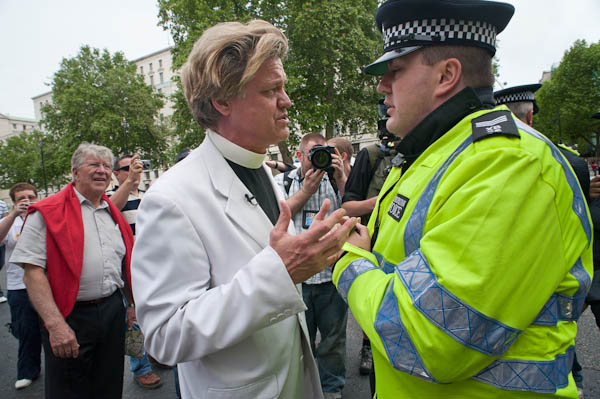
"Officer, I can see you have a shopping problem"
more pictures
The Reverend Billy and his 'Life After Shopping' Gospel
choir from New York were busy in London today on their 2009 UK Shopocalypse
Tour.
I met them at Downing St, where they gave a brief performance, although unfortunately
Gordon Brown wasn't at home. The police at this high security site, now hidden
behind tall gates with armed guards, obviously didn't quite know how to handle
the holy activists, and the officer who stopped the Reverend to question him
failed to make much progress - other than being diagnosed by Billy as having
a "shopping problem."
The Church of Life After Shopping believes that we need to "back away
from the product" and resist the way that advertising and the media persuade
us to live only thorough consuming corporate products, and get down to experiencing
life directly.
We can live more by consuming less - and at the same time help save the planet
and put an end to climate change, which is a result of our excessive consumption.
It's a message that comes from New York, and Americans consume far more than
people in other countries, but the UK also has much higher levels of consumption
than are sustainable in the future, particularly if we want (or are forced)
to move towards a fairer sharing of resource usage between rich and majority
worlds.
Downing St was of course a key site at which to protest consumerism, which
has been central to the expansion of our economy, but in many ways we now
see to be a false God. As Billy says, following the G20 summit and the pathetic
waste and greed shown in the continuing parliamentary allowances scandal,
our government and MPs are clearly in need of the Life After Shopping Gospel.
Amen indeed brother!
more pictures
Southern Yemenis Demonstrate For a Separate State
Downing St, Whitehall, London. Saturday 23 May, 2009
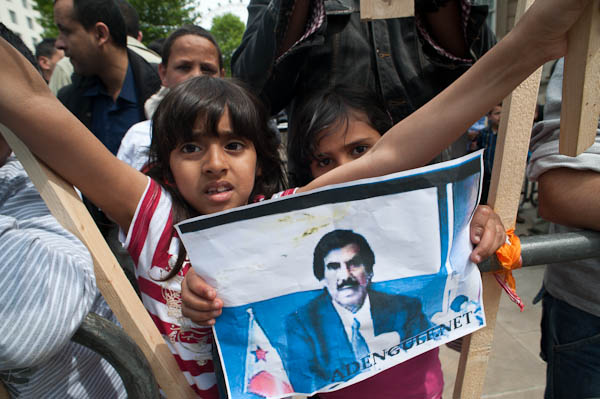
Demonstrators in the pen on Whitehall
more pictures
Several people were killed in and many injured Aden last week when demonstrations
there marked the 15th anniversary of the unsuccessful attempt by the southern
Yemen leader Ali Salem al-Beidh to end the union with the north, which led
to the 1994 civil war, lost by the South.
Southern Yemenis from the Southern Democratic Assembly (TAJ), based in London,
demonstrated at Downing St in London on Saturday, calling for an end to the
union.
They claim that the government has marginalized the South, and uses repressive
methods to control the south.
Slogans on display in the London demo were mainly in Arabic, but those in
English included:
- Shame on Northern People for their silence. No More Silence.
- Freedom for the Leaders of the Southern Peaceful Revolution in the Yemen
Occupation's Jails
- We call for an end to the Northern Military occupation
- End the Repression of Southerners. We have no more patience
Southern Yemen, a former British protectorate including Aden and the surrounding
area, was granted independence as a socialist republic in 1967, and changed
its name to the People's Democratic Republic of Yemen two years later. North
Yemen, under Ottoman rule until 1918, was a kingdom until 1962 when it became
the Yemen Arab Republic. A decision in principle had been made in 1972 to
unite the two countries, and this took place in 1990, when the present Republic
of Yemen was formed.
Southern Yemen has most of the oil reserves of the country and other resources.
TAJ accuse the Government of grabbing land and property and of human rights
abuses.
Southern Yemeni leader al-Beidh, in a speech broadcast on Aljazeera, said
"The national government has betrayed the people of the south.
It has taken the land and resources as war booty, and has turned the south
from a partner into occupied."
Other commentators suggest that people in other areas of Yemen are equally
dissatisfied with the government and that looting by the military as well
as chronic poverty and endemic corruption is nationwide. Yemen is a country
racked by factionalism and tribalism, and many feel any the secession of the
south would lead to a complete breakdown of the state.
The Yemen is a very highly militarised state, and its break-up could threaten
the stability of its neighbour Saudi Arabia. The area might become a haven
for Al-Qaeda terrorists - a future Afghanistan, and it could also threaten
the efforts to stop Somali pirates.
Many critics of the government call for a crackdown on corruption, a change
in the constitution which would give areas such as South Yemen a greater autonomy
over their own affairs, and to hand power to a progressive coalition. The
US government is among those putting pressure on the Yemenis to make changes.
more pictures
March to Defend Jobs, Services and Education
Highbury Fields to Archway, London. Saturday 23 May, 2009
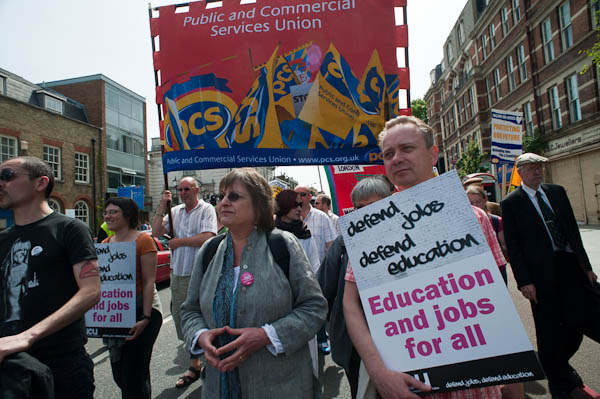
The march on Holloway Road
More pictures
Around five hundred workers in North London took part in a march and rally
to defend jobs, services and education on Saturday 23 May, 2009, walking from
Highbury Fields to a rally at Archway, where speakers included local MP Jeremy
Corbyn and local trade union learers.
The march was prompted by the loss of 1500 jobs in the area, including 550
mainly support workers from London Metropolitan University, 500 civil servants
from Archway tower and more at City University, where adult education is under
threat. The marchers included teachers and lecturers, students and support
staff, civil servants and supporters. It was supported by many local groups
including the Islington National Union of Teachers, the Public & Commercial
Services Union, London Metropolitan University Unison and the University and
College Union.
As well as the loss in jobs, these cuts also particularly threaten courses
and provision such as nurseries that enable many students who have missed
out on education a chance to gain qualifications.
More pictures
Photography Matters: NUJ Photographers Conference
Institute of Education, London. Monday 18 May, 2009
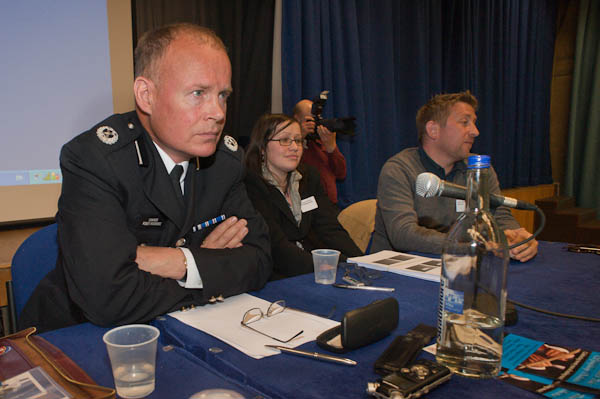
Met public order supremo Commander Bob Broadhurst
listens as photographers attack policing in London
more pictures
The NUJ's second Photographers' Conference turned out to be rather more interesting
than the first, which at times seemed to be more an Adobe shop window than
anything else. I think there was one technical presentation, on colour management,
but most of us were busy eating lunch.
With two of the sessions split into alternative groups I couldn't hear everything,
but in the morning we got both some enlightenment and enjoyment. Paul
Herrmann of Redeye included some good advice, but it was all a little
too much about becoming the next Martin Parr for my taste (no offence to Martin,
but there are other roads.) Nick McGowan-Lowe gave a very sound presentation
on how to ensure your web site works for your business (this one does almost
nothing for mine.) David Hoffman, one of the few speakers not to
use pictures, started by talking about his 30 years of building his business
as "a client-free zone" and went on to consider the future
and the possibilities of surviing the avalanche by surfing on it , getting
into the latest developments and going with them. It was perhaps the most
challenging speech of the day.
Kevin Cooper's notes on covering demonstrations were a useful reminder,
particularly for the more dangerous events, coming from his experience in
Northern Ireland. The handout also included information on trauma and on the
International Press Card issued by the International Federation fo Journalists,
vital for those working abroad.
Penny Tweedie's romp through her career after the coffee-free break
was highly entertaining as well as provoking thought. Only around 40 years
ago the NUJ had stepped in to stop her getting a staff job in Fleet Street
- on the grounds that she was a woman and thus wouldn't be able to cope with
the difficult jobs that might come her way, particularly when she was the
only photographer on the night shift. She set out to show them she could and
certainly did.
Another thought-provoking incident came during the India-Pakistan war in
1971, when she was one of the group of photographers who walked away from
an incident when they thought that their presence was actively provoking violence
against prisoners - seconds before the bayoneting that got Horst Faas and
Michel Laurent a Pulitzer Prize.
After lunch - which gave us a chance to look at the 2009
NUJ Photography Matters exhibition - came law and order, with Rupert
Grey and Emma Hulme giving us a detailed view of the legal position
and Jeff Moore and Paul Stewart presenting a slide show
of police behaving well and, more commonly, badly on the street.
The came Commander Bob Broadhurst, very much sticking his head into
the lion's den. His address came to an early end in uproar after he talked
about the "phalanx of cameras" getting in the way of police
at the G20 and added "I don't know whether, or what vetting system
there is for holding an NUJ card, can anybody apply for an NUJ card who has
a camera?"
Two hundred people jumped up to tell him that it isn't such a thing as an
NUJ card, but a UK Press Card, issued by gatekeepers for
the UK Press Card Authority under a scheme recognised by the Association
of Chief Police Officers, and only available to bona fide newsgathers
who have to work in public situations. But despite this clarification, Broadhurst
continued to show his scepticism in several later remarks.
After the police actions against journalists at the G20 demonstrations, where
police deliberately targetted photographers, Broadhurst must have expected
a difficult time, and he got it. One photographer described how a police officer
in riot gear told him he didn't care he was press as he held up his press
card and proceeded to hit him with his truncheon, fracturing his arm. Another
raised the incident on May 2 when and officer threated a group of around 20
photographers behind a police cordon with arrest under the Public Order Act
unless they went away for half an hour when the police wanted to set dogs
on some protesters. The official police excuse that they were unaware that
those concerned were press, lacked conviction as the video of the event records
the officer starting his threat with the words "Ladies and Gentlemen
of the Press."
more pictures
Circle the City: Christian Aid Sponsored Walk
City of London, Sunday 17 May, 2009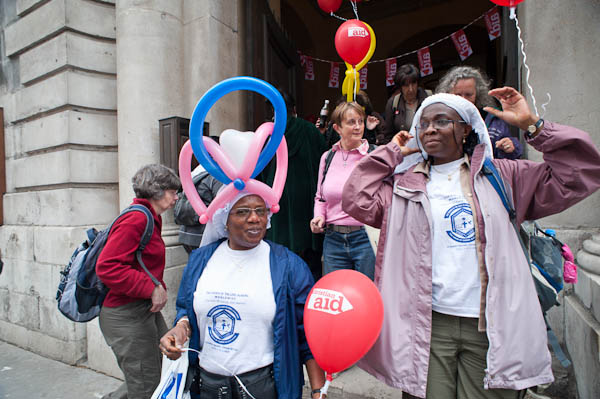
Other walkers leave a pre-walk service at St Mary-le-Bow, Cheapside
more pictures
Sunday afternoon I followed a woman with a red balloon on a six mile (10
km) trail around the city, or rather two cities of London and Southwark, which
led us to around 30 different ritual locations. We gained access to many of
these and in several were offered drinks and food.
It was Christian Aid's 'Circle the City' a fund-raising sponsored
stroll from church to church to church... the woman was rather well known
to me and all I got to drink was tea, coffee and lemon squash, though the
asparagus quiche at All Hallows by the Tower was delicious.
In the course of our walk we got to see - if only rather briefly - the interiors
of some of Wren's finest, and one or two by other architects. And the event
at the end of Christian Aid Week had raised a considerable amount
for the projects that Christian Aid supports in the majority world.
more pictures
Walton on the Hill May Pageant
Walton on the Hill, Surrey. Saturday 16 May, 2009
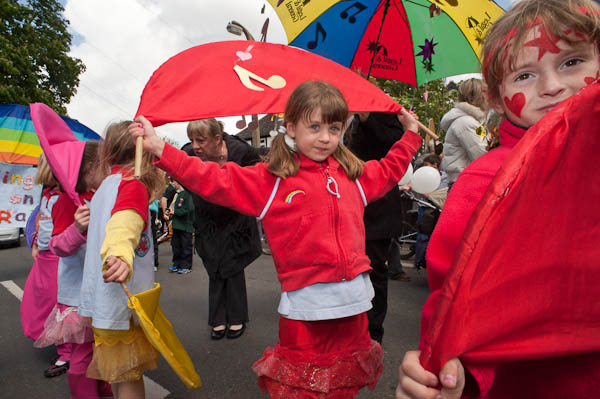
more pictures
Almost 30 different groups took part in the procession which forms a part
of Walton on the Hill's May Fayre, including the Vicar and her church choir
sitting on hay bales in a cart pulled by a tractor, various school and nursery
groups, youth groups and more. And there's a May Queen in a car with her rather
mixed entourage in a Youngs brewery dray. You can see more pictures about
the May Queen that I took here
in 2007.
This May Pageant was started (or 'revived') forty years ago in 1969 and seems
to enjoy wide popular support unlike many similar carnivals elsewhere, with
crowds in the streets following it, making it hard to take pictures.
By the time I'd reached the fairground at the end of the procession I was
feeling rather tired, and it was time to find somewhere to sit and have a
drink before going home, so this time I didn't photograph the events after
the procession.
more pictures
Pratt's Bottom May Queen
Pratt's Bottom, Bromley, London. Saturday 16 May, 2009
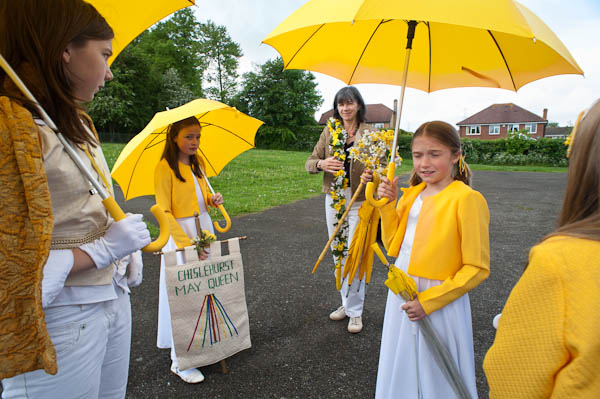
Chislehurst May Queen waiting for start of procession at Pratt's Bottom
more pictures
It was cold dismal and spitting with rain when we arrived at Pratt's Bottom
near Orpington, and the recreation ground was empty, but soon people began
to turn up for the procession tothe Village Fete. As well as a cadet marching
band and Miss Bromley, the procession also included May Queen groups from
Green Street Green, Orpington, Pett's Wood and Pratts Bottom itself (although
all the maps show it as Pratt's Bottom, those in the village seem to prefer
it without the apostrophe.) Pratt's Wood seems very much out in the country
and its May Queen group seems to be the outler among the groups which take
part in the London May Queen.
Fortunately the rain stopped and the sun came out for the procession up the
hill to the Fete, but the band at the front set a cracking pace, probably
to warm themselves up, and the smaller members of the Queens' retinues had
a job keeping up.
At the top of the hill was the usual fete (here are more pictures from last
years rather wetter event) around the green, and in a brief ceremony this
year's Pratt's Bottom May Queen was crowned by last year's queen, and Miss
Bromley officially opened the fete, while I left to go to another May Fayre.
more pictures
Derbyshire Interlude
Curbar & Baslow, Derbyshire
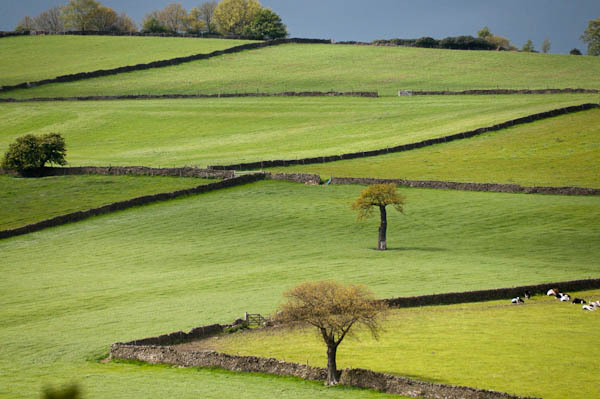
Dry stone walls, fields, trees, cows, sky
A few pictures from Derbyshire where I went to a conference
more pictures
Strangers Into Citizens
Lambeth to Trafalgar Square, London. Monday 4 May, 2009
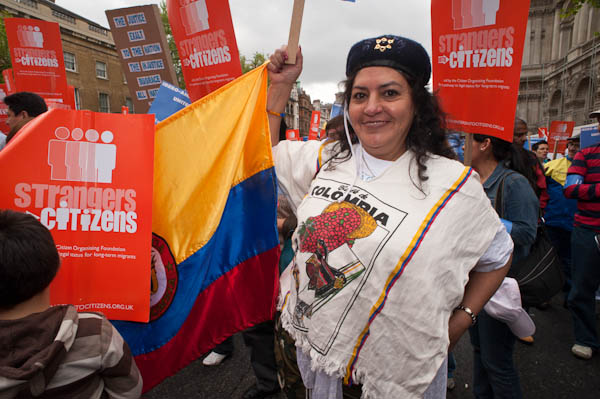
The march comes up Whitehall towards the rally in Trafal;gar
Square
more pictures
Strangers into Citizens calls for a pathway to give long term irregular migrants
a right to earn indefinite leave to stay in this country. Current best estimates
are that around 725,000 people are currently living in the UK without a documented
right to remain. They include asylum seekers whose cases have not been determined
or who have been refused but have not been removed and those who have stayed
on after temporary visas or permission to stay has expired.
Strangers into Citizens propose that these 'undocumented' migrants who have
been in this country for more than four years should be elegible for a two-year
work permit. At the end of this they should, "subject to criteria such
as an English language test, a clean criminal record and valid references
from an employer and community sponsor" be granted indefinite leave to
remain.
These people are with us, many taking a valuable and active part in the communities
in which they live. An amnesty for them makes sense on moral, religious, practical
and economic grounds - at current removal rates it would take over 30 years
and cost around £8bn to forcibly remove them, and they make a positive
contribution to our economy.
Tens of thousands of supporters, mainly migrants came together in a march
to a rally in Trafalgar Square. Many of them had earlier been at religious
services in seven different locations in London. I joined the mainly Latin
American march at North Lambeth - it had started at the Elephant and it joined
up with most of the rest of the marchers at Parliament Square.
There were many - too many - speakers at Traflagar Square, representing the
huge range of support for the proposal from religious, polictical and trade
union groups as well as various ethnic groups and migrants from a number of
countries. The rally ended with musical performances and a lively troupe of
dancers.
more pictures
Banstead Village May Queen
Banstead, Surrey. May 2, 2009
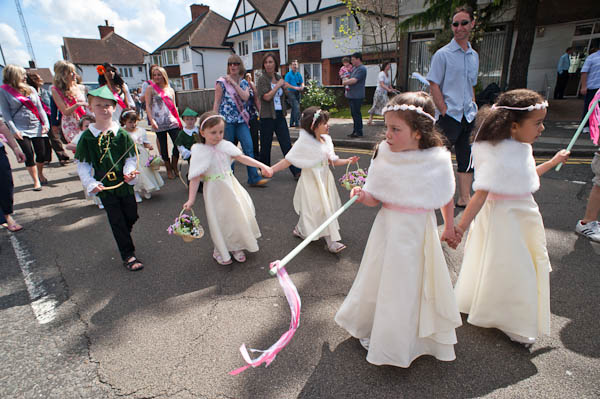
The May Queen group in the procession to The Orchard for the crowning
more pictures
This was the 25th year of the Banstead May Queen, and there were a dozen
or so of the previous May Queens taking part. The event is a part of the Banstead
May Fayre and the procession includes all sorts of of other groups from the
area as well as the May Queen and her retinue.
The procession goes the length of the High St to the roundabout and then
back to The Orchard, a large grassed area in front of the Parish Church, where
the fair is held. This year's Queen was crowned in a very brief ceremony by
last year's May Queen and then she proceeded to make a short speech thanking
various people for their contribution to the event, including her mother.
This year she had the added duty to present gifts to the previous May Queens
who had come to the event.
Displays of country dancing, maypole dancing and other performances then
continued in the arena, while around there was a large area of stalls run
by local groups - a typical large garden fete. This is obviously a very popular
event in Banstead with around a thousand people coming out to watch the procession.
more pictures
Guilty - G20 Protesters Hand Themselves In
Bank, City of London. 1 May 2009
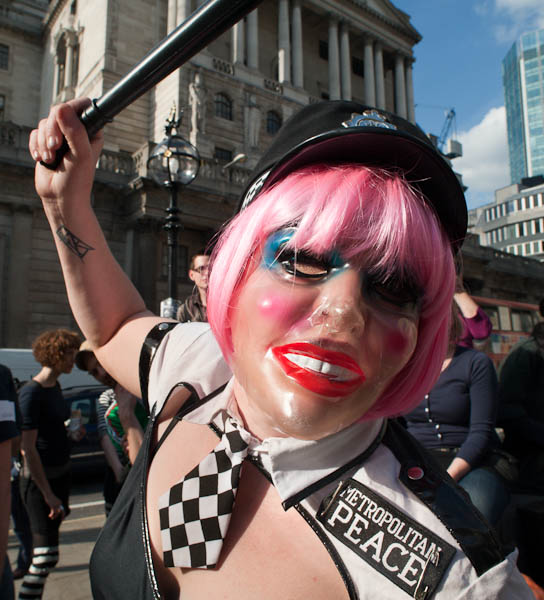
Protester dressed as 'Metropolitan Peace' threatens photographer
with baton
more pictures
The Space Hijackers organised 'Guilty', an event starting
at Bank at 17.04, inviting people to come dressed either as guilty criminals
or as police, and for the guilty to give themselves in. This was a protest
against the police violence in attacking largely peaceful demonstrators on
April 1. Although a much smaller event, those present were the core of the
G20 demonstrators, including some of the G20 Meltdown organising group who
had brought their maypole for some May Day celebrations.
This time the police simply lined up in front of some of the more vulnerable
sites in the area and stood back and watched. With no police provocation or
attacks, this was a good-natured and peaceful event for the whole of the time
I was there.
Had the police taken a similar laid-back approach on April 1, contenting
themselves with protecting obviously vulnerable key sites - such as the RBS
branch in Threadneedle St - there would probably have been little more trouble.
Kettling - the surrounding and detention of groups of people, provocative
actions by FIT teams and forcing people to remove masks, the use of riot police,
dogs and police horses, police charges against media and demonstrators and
related actions led to a great deal of minor injury as well as the death of
an unfortunate bystander who was caught up in the police violence.
And of course to some damage to property. The most vulnerable and likely
target for the small minority of demonstrators out to cause damage to property
was only defended by a realtively small number of police compared with the
huge forces confining demonstrators into an area where trouble was likely.
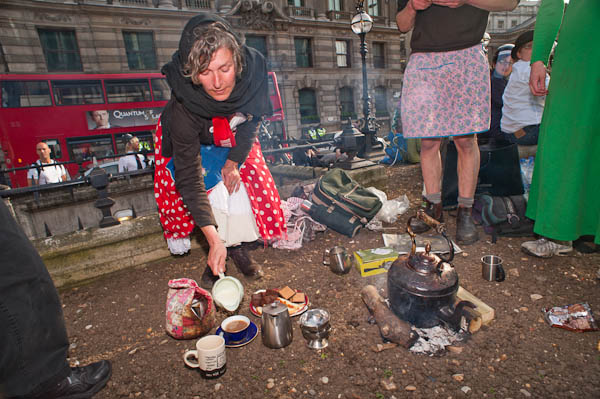
A number of those at 'Guilty' had brought kettles as a protest, and some
made a carbon-neutral wood fire to boil up on and had a tea party. I'm pleased
to be able to report that Marina wasn't a 'Miffy' and the biscuits were rather
nice.
more pictures
Visteon Picket KPMG Over Pensions
Salisbury Square, London. 1 May 2009
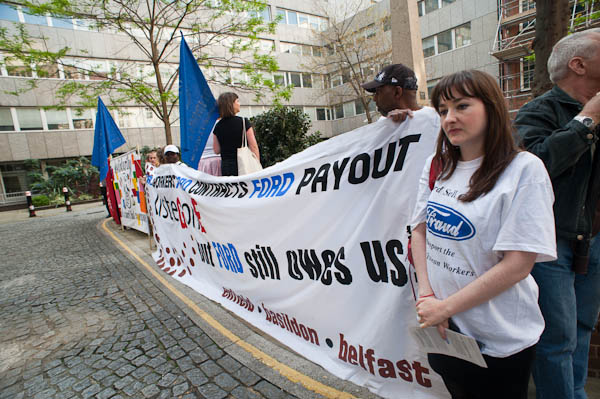
Sacked Visteon worksers brought their banners to protest at administrators
KPMG
more pictures
Although the sacked VIsteon workers have obtained imporved severance payments
through fighting for their rights, there are still problems with their pensions.
UK law doesn't adequately protect the funds paid in by employer and employee
from unscrupulous managements, and pension funds can disappear. After the
May Day rally, some former Visteon employes made their way to Fleet Street
where they demonstrated outside the offices of the company administrator,
KPMG, calling for their pension funds to be made avaialble in full to provide
future pensions for the ex-employees.
more pictures
May Day March & Rally
Clerkenwell Green & Trafalgar Square, London. 1 May 2009
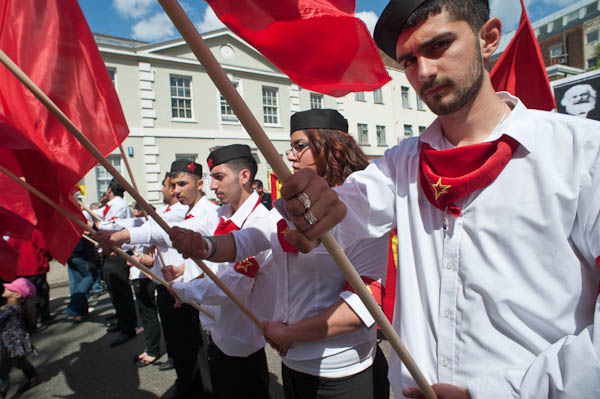 The
march was as usual started at Clerkenwell Green
The
march was as usual started at Clerkenwell Green
more pictures
May Day should be a Bank Holiday, but instead we have a
silly 'not quite May Day' on the first monday of the month. But trade unionists
and various communist groups, particularly from the Turkish and Kurdish communities
celebrate International Workers Day with a march through London and a rally
at Trafalgar Square on May 1.
This year's event was a little more complicated, with an anarchist rally
and a May celebration complete with maypole by the G20 Meltdown organisers
also taking part on Clerkenwell Green. There was a small autonomous group
on the march but most of the anarchists decided they would continue their
meeting in the pub.
One controversial group on the march was the Janatha Vimukthi Peramuna,
JVP, a Sinhalese group formed in 1965 as a nationalist, Marxist-Leninist,
Communist political party. It 1971 it led an unsuccesful revolution in which
15,000 young people were killed, and it was proscribed, but later emerged
to take part in democratic politics at local and national level, becoming
part of the government in 2004. In 2005 the JVP lent their support to the
new Sri Lankan president Mahinda Rajapakse, enabling him to form a majority
government in return from a promise by him not to grant the division into
federal states demanded by the LTTE which could have been the basis for a
succesful peace settlement in the country. The alternative was the stepping
up of miilitary activity to annihilate the Tigers now close to conclusion.
I had a few technical problems - like one of my older lenses deciding to
stop focusing properly and then lbasically fall to pieces during the morning
and . So there are a few less pictures from the Clerkenwell Green than usual.
Later I managed to get it to more or less work with a little brute force and
manual focus.
The rally at Trafalgar Square was frankly rather dull - and numbers in the
square thinned out rapidly well before the end. Those leaving early missed
a powerful address from one of the Visteon workers, as well as a vintage performance
from Tony Benn, who seemed much livelier than at most recent events.
more pictures
top of page
All pictures on this section of the site are Copyright ©
Peter Marshall 2009; to buy prints or for permission to reproduce pictures
or to comment on this site, or for any other questions, contact
me.




















 The
march was as usual started at Clerkenwell Green
The
march was as usual started at Clerkenwell Green